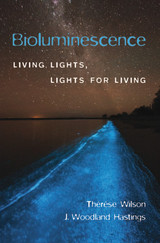
In the early 1960s, in a small shack on the Washington coast, a young, self-educated Japanese scientist performed an experiment to determine what made a certain jellyfish glow. The substance he discovered, green fluorescent protein, would revolutionize molecular biology, transforming our study of everything from the AIDS virus to the workings of the brain. Aglow in the Dark follows the path that took this glowing compound from its inauspicious arrival on the scientific scene to its present-day eminence as one of the most groundbreaking discoveries of the twentieth century.
The story unfolds in far-flung places, from the coral reefs of the Pacific Ocean, to the medical schools and marine stations of our leading universities, to a cold war-era research laboratory in Moscow. Traversing the globe and the decades, Aglow in the Dark conveys the human fascination with bioluminescence, or "living light," its little-known application in war, forensic science, and molecular biology, and how it led to the finding of green fluorescent protein. The book reveals a hidden world where light is manipulated by animals and humans and put to remarkable uses--unlocking the secrets of the human brain, conquering dreaded diseases, and perhaps someday linking minds and machines. The authors deftly lead the reader through a complex story at the interface of biology and physics--and into the realm of wonder on the frontiers of scientific endeavor.

Bioluminescence is everywhere on earth—most of all in the ocean, from angler fish in the depths to the flashing of dinoflagellates at the surface. Here, Thérèse Wilson and Woody Hastings explore the natural history, evolution, and biochemistry of the diverse array of organisms that emit light.
While some bacteria, mushrooms, and invertebrates, as well as fish, are bioluminescent, other vertebrates and plants are not. The sporadic distribution and paucity of luminous forms calls for explanation, as does the fact that unrelated groups evolved completely different biochemical pathways to luminescence. The authors explore the hypothesis that many different luciferase systems arose in the early evolution of life because of their ability to remove oxygen, which was toxic to life when it first appeared on earth. As oxygen became abundant and bioluminescence was no longer adequate for oxygen removal, other antioxidant mechanisms evolved and most luminous species became extinct. Those light-emitting species that avoided extinction evolved uses with survival value for the light itself. Today’s luminous organisms use bioluminescence for defense from predators, for their own predatory purposes, or for communication in sexual courtship.
Bioluminescence was earlier viewed as a fascinating feature of the living world, but one whose study seemed unlikely to contribute in any practical way. Today, bioluminescence is no longer an esoteric area of research. Applications are numerous, ranging from the rapid detection of microbial contamination in beef and water, to finding the location of cancer cells, to working out circuitry in the brain.
READERS
Browse our collection.
PUBLISHERS
See BiblioVault's publisher services.
STUDENT SERVICES
Files for college accessibility offices.
UChicago Accessibility Resources
home | accessibility | search | about | contact us
BiblioVault ® 2001 - 2024
The University of Chicago Press









